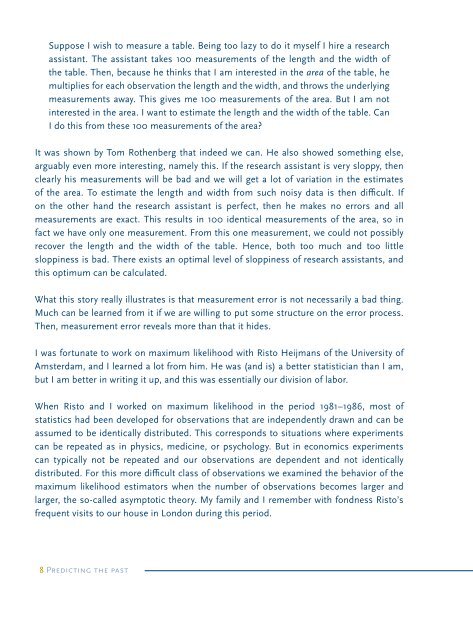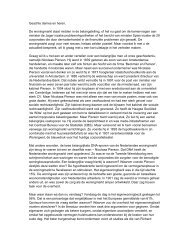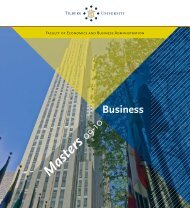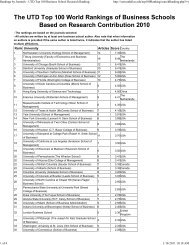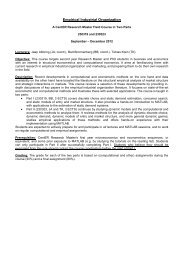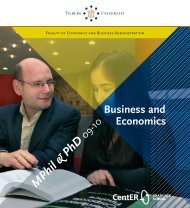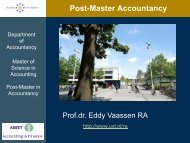Predicting the past - Tilburg University, The Netherlands
Predicting the past - Tilburg University, The Netherlands
Predicting the past - Tilburg University, The Netherlands
Create successful ePaper yourself
Turn your PDF publications into a flip-book with our unique Google optimized e-Paper software.
Suppose I wish to measure a table. Being too lazy to do it myself I hire a research<br />
assistant. <strong>The</strong> assistant takes 100 measurements of <strong>the</strong> length and <strong>the</strong> width of<br />
<strong>the</strong> table. <strong>The</strong>n, because he thinks that I am interested in <strong>the</strong> area of <strong>the</strong> table, he<br />
multiplies for each observation <strong>the</strong> length and <strong>the</strong> width, and throws <strong>the</strong> underlying<br />
measurements away. This gives me 100 measurements of <strong>the</strong> area. But I am not<br />
interested in <strong>the</strong> area. I want to estimate <strong>the</strong> length and <strong>the</strong> width of <strong>the</strong> table. Can<br />
I do this from <strong>the</strong>se 100 measurements of <strong>the</strong> area?<br />
It was shown by Tom Ro<strong>the</strong>nberg that indeed we can. He also showed something else,<br />
arguably even more interesting, namely this. If <strong>the</strong> research assistant is very sloppy, <strong>the</strong>n<br />
clearly his measurements will be bad and we will get a lot of variation in <strong>the</strong> estimates<br />
of <strong>the</strong> area. To estimate <strong>the</strong> length and width from such noisy data is <strong>the</strong>n difficult. If<br />
on <strong>the</strong> o<strong>the</strong>r hand <strong>the</strong> research assistant is perfect, <strong>the</strong>n he makes no errors and all<br />
measurements are exact. This results in 100 identical measurements of <strong>the</strong> area, so in<br />
fact we have only one measurement. From this one measurement, we could not possibly<br />
recover <strong>the</strong> length and <strong>the</strong> width of <strong>the</strong> table. Hence, both too much and too little<br />
sloppiness is bad. <strong>The</strong>re exists an optimal level of sloppiness of research assistants, and<br />
this optimum can be calculated.<br />
What this story really illustrates is that measurement error is not necessarily a bad thing.<br />
Much can be learned from it if we are willing to put some structure on <strong>the</strong> error process.<br />
<strong>The</strong>n, measurement error reveals more than that it hides.<br />
I was fortunate to work on maximum likelihood with Risto Heijmans of <strong>the</strong> <strong>University</strong> of<br />
Amsterdam, and I learned a lot from him. He was (and is) a better statistician than I am,<br />
but I am better in writing it up, and this was essentially our division of labor.<br />
When Risto and I worked on maximum likelihood in <strong>the</strong> period 1981–1986, most of<br />
statistics had been developed for observations that are independently drawn and can be<br />
assumed to be identically distributed. This corresponds to situations where experiments<br />
can be repeated as in physics, medicine, or psychology. But in economics experiments<br />
can typically not be repeated and our observations are dependent and not identically<br />
distributed. For this more difficult class of observations we examined <strong>the</strong> behavior of <strong>the</strong><br />
maximum likelihood estimators when <strong>the</strong> number of observations becomes larger and<br />
larger, <strong>the</strong> so-called asymptotic <strong>the</strong>ory. My family and I remember with fondness Risto’s<br />
frequent visits to our house in London during this period.<br />
8 <strong>Predicting</strong> <strong>the</strong> <strong>past</strong>


